27 September and 7 October 2022



Anyway, I don’t want to repeat the same history or descriptions of what we saw or did. So for the places I visited twice, I’ll combine the two dates of the location.
Spoleto is a wonderful hill town, and one of 

Spoleto also has a duomo – although inside, you barely see the dome, it's that small. Confusing, I 

But the Spoleto duomo is 
I also think Spoleto has 

Keiko and Anne opted to stay in the Piazza di Mercato to paint. I visited a little local shop, where the owner and I had a discussion (in Italian) about the better salsa tartufata and how many people it would serve. (He  kept telling me the small jar was “molto forte!” – very strong, so we didn’t need much.) I also bought a jar of black truffle honey – sounds weird but it is truly delicious over cheese, with sliced fruit. Perfect Italian dessert!
kept telling me the small jar was “molto forte!” – very strong, so we didn’t need much.) I also bought a jar of black truffle honey – sounds weird but it is truly delicious over cheese, with sliced fruit. Perfect Italian dessert!
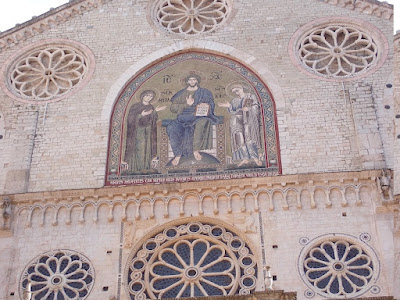 Anyway, I left the other two in the square, and walked toward the Duomo. Signage was confusing, so I asked some older gentleman (in Italian) the way to the Duomo. He wasn’t sure, he was from Rome, but he pointed me in the right direction and said to turn left. I wandered
Anyway, I left the other two in the square, and walked toward the Duomo. Signage was confusing, so I asked some older gentleman (in Italian) the way to the Duomo. He wasn’t sure, he was from Rome, but he pointed me in the right direction and said to turn left. I wandered  on, taking pictures of things like old arches, interesting buildings, things like that. I came to another intersection and was debating which way, when my new Roman friend walked by. He asked if I had been to the Duomo yet, I said no, I am slow, many photos – he laughed
on, taking pictures of things like old arches, interesting buildings, things like that. I came to another intersection and was debating which way, when my new Roman friend walked by. He asked if I had been to the Duomo yet, I said no, I am slow, many photos – he laughed  and pointed me in the right direction once again. Don’t you love making new friends who are so helpful?
and pointed me in the right direction once again. Don’t you love making new friends who are so helpful?
Of course, I was slowed down by ceramic signs, gorgeous café tables with incredibly detailed ceramic tops, all those  little things one finds in other parts of the world that make it so interesting. And a crazy fountain, or maybe a horse trough, made from a Roman sarcophagus from the 3rd century. (Could be CE, could be BCE, I have no idea. The Italian sign says III
little things one finds in other parts of the world that make it so interesting. And a crazy fountain, or maybe a horse trough, made from a Roman sarcophagus from the 3rd century. (Could be CE, could be BCE, I have no idea. The Italian sign says III  Sec. DC - and of course I don't know what the DC means.)
Sec. DC - and of course I don't know what the DC means.)
I made it to the Duomo, and walked inside. Made it halfway down toward the altar when music came blaring on over the speakers – Mendelssohn’s Wedding  March!!! So random and funny!!! Anyway, a woman in an apron saying “Servicio” was frantically speaking on her telefonino, and walked up to me. She said something in Italian about the music, the noise – I think she was apologizing it was so loud. I asked about
March!!! So random and funny!!! Anyway, a woman in an apron saying “Servicio” was frantically speaking on her telefonino, and walked up to me. She said something in Italian about the music, the noise – I think she was apologizing it was so loud. I asked about 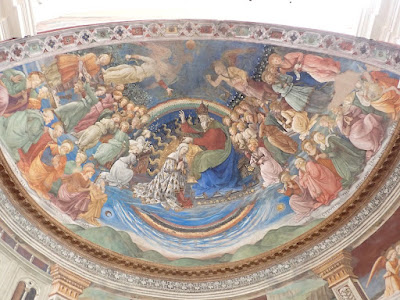 Fra Filippo Lippi, and she pointed out the red and white marble tomb, and then his painting in the apse (the indented wall and ceiling area behind the altar). I asked if photos were okay – she said yes, everything except some statue. Fine, I only wanted the
Fra Filippo Lippi, and she pointed out the red and white marble tomb, and then his painting in the apse (the indented wall and ceiling area behind the altar). I asked if photos were okay – she said yes, everything except some statue. Fine, I only wanted the  Lippi. I pretty much had the entire church to myself as she walked off to deal with the music problem. (It never was turned down, and continued to blare out music, although it then went to less triumphant pieces.)
Lippi. I pretty much had the entire church to myself as she walked off to deal with the music problem. (It never was turned down, and continued to blare out music, although it then went to less triumphant pieces.)
 The Lippi paintings show the life of Mary – first an annunciation scene, then trek to Bethlehem, and so forth. The dome above the apse shows Mary’s ascension to heaven, with an amazing cobalt blue background and a benevolent Heavenly Father greeting her in the clouds, with angelic
The Lippi paintings show the life of Mary – first an annunciation scene, then trek to Bethlehem, and so forth. The dome above the apse shows Mary’s ascension to heaven, with an amazing cobalt blue background and a benevolent Heavenly Father greeting her in the clouds, with angelic  orchestras and choruses to the side. (For people who like to know dates, Lippi painted this from 1467 to 1469.)
orchestras and choruses to the side. (For people who like to know dates, Lippi painted this from 1467 to 1469.)
These paintings absolutely glow – frescoes (paintings on fresh wet plaster) are not easy to accomplish, but the way the  calcium crystallizes around the paint pigment in the plaster does something that somehow makes the images more alive. Well, and Lippi truly was a master at painting, whether in fresco or oil.
calcium crystallizes around the paint pigment in the plaster does something that somehow makes the images more alive. Well, and Lippi truly was a master at painting, whether in fresco or oil.
 So I spent time just looking and enjoying
So I spent time just looking and enjoying
The “model” for the Mary in this series of frescoes was so familiar to me – she is the woman pictured in various Lippi paintings, almost always as Mary. She has just a perfectly symmetrical face, with the serenity someone might ascribe to a saint. Blonde, serene, young, lovely.
I knew the story, written by Vasari, a late Renaissance artist best known for his book The Lives of the Artists. He really was all about the gossip of the day, though he did include more scholarly analyses of the artwork produced during the Renaissance.
So, the story – Fra Filippo Lippi was a monk, as well as an artist. He met and fell in love with Lucretia Buti, who either was a nun or was under the protection of the sisters in some convent. Lucretia either went willingly, or Lippi abducted her, and they spent several weeks at his home. She later gave birth to his son, also named Filippo Lippi (without the Fra, which means “brother”), and Lippi and Lucretia were a couple for a number of years. (There may or may not have been a second child.)
Eventually, Lippi left his monastery, and the Pope of the time granted him permission to marry Lucretia. There’s some mystery around his death – Lippi was nearly finished with the amazing painting in the Duomo when he died unexpectedly. Some say he was poisoned by Lucretia for having affairs, others say he was poisoned by another woman who he scorned. No one knows for sure. But the upshot was that he died, and was buried at the church with an ornate marble tomb commissioned by Lorenzo il Magnifico and designed by Lippi’s son.
Celebrity gossip, right?!? Side note – apparently Lucretia Borgia was appointed governor of Spoleto by her father, Pope Alexander VI. No wonder Lippi wasn’t excommunicated or something for having a long relationship and a few children with a nun!
Shortly after I had my fill of the artwork, or at least for that day, I turned to walk out as busloads of tourists entered. Definitely time to leave!
Outside the Duomo is another church, with sort of a scenic overlook area to the side. From there, I could see a small park just below the set of stairs to the right. I wandered on down, and sat in the park, enjoying the green and the quiet. I painted a sketch of lower Spoleto, and then, as it was drying, raced back to the area just outside the city gate to meet our mini bus. (Periodically asking people for directions to the main plaza near the Roman theatre.)
I came upon a group of teenage boys who seemed to be picking on one particular kid – and being a retired teacher, I could see this might be a fight in the making. So I intervened by walking up and asking, in my not great Italian, for directions. Diversion works every time! The oldest boy, maybe 16 or so, told me in perfect English that he didn’t speak English, but this other boy did. They all looked at my map, I pointed out the X where I was to meet my bus, they pointed out the traffic circle where I should turn left. (Or right, there was some discussion about the correct word for that direction. It isn’t only me who mixes up the two!)
Anyway, I thanked them and walked on, and they walked off the other way, fight stopped and friends again.
Okay, my view from the park, and my watercolor sketch. I'll add the large versions of the Lippi photos here, and then continue on to my second visit to Spoleto - so feel free to either enjoy the sumptuous beauty of Lippi, or skip right to Spoleto part 2. I won't mind. (Or even know!)


On our way, we walked by a huge group of young school children being addressed by someone outside what we think was city hall – the man had a huge 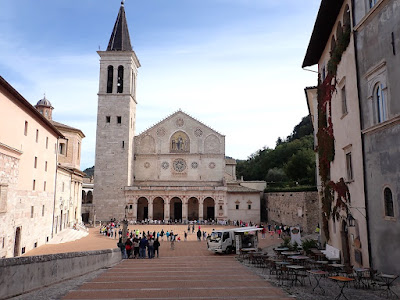
 elementary school age, though a few might have been as old as 10 or 11. They all were very cute.
elementary school age, though a few might have been as old as 10 or 11. They all were very cute.
This time, the music in the Duomo was a bit more subdued. More areas were roped up, in part due to someone working on the electric  system. The lighting in the apse was off and on, so the photos aren’t as great. But Lippi’s paintings once again filled my soul.
system. The lighting in the apse was off and on, so the photos aren’t as great. But Lippi’s paintings once again filled my soul.
We planned to walk back to the Piazza di Mercato by early afternoon so our instructor, Nancie, could give a 

 black truffles. Bruschetta (pronounced broo-SKEH-tah – and NOT broo-SHEH-tah) with black truffles. Melted cheese in a small ramekin, sprinkled with black truffle. Sautéed mushrooms, likely with more black truffle. And then some farro salad, and cooked chicory, both without truffle. The meal included water, and choice of wine. (I can’t drink wine mid-day, it gives me a headache all afternoon, so I told the adorable young waiter he could have my glass of wine.)
black truffles. Bruschetta (pronounced broo-SKEH-tah – and NOT broo-SHEH-tah) with black truffles. Melted cheese in a small ramekin, sprinkled with black truffle. Sautéed mushrooms, likely with more black truffle. And then some farro salad, and cooked chicory, both without truffle. The meal included water, and choice of wine. (I can’t drink wine mid-day, it gives me a headache all afternoon, so I told the adorable young waiter he could have my glass of wine.)
It was a delicious and delightful meal! We made it to the piazza in time for the demo, though I ended up painting a quick sketch of the gorgeous clock in the square, on the tower right above the fountain. I tend to focus on small and different sort of details, rather than doing artwork of a larger scene. No idea why, just how I like to work. Plus it was a wonderful clock, with a sky blue face and golden hands like the rays of the sun. With extra squiggly lines, truly making the clock look like a shining sun in the sky. (Yes, my numbers are wrong. I was chatting with others, and somehow lost track of my Roman numerals. Oh well. Quirky numbers for a new style clock.)
In Italy, the standard afternoon snack seems to be a small serving of gelato. Or at least that is the trend amongst tourists. The nearby gelato shop had an incredible flavor, dark chocolate with orange!!! (Cioccolata fondante con arancia!) My standard combo is dark chocolate and coffee, because in Italy it is expected to have more than one flavor, even in a small cup or cone. So I ordered the dark chocolate with orange, and the caffe. What an amazing flavor combination!!! SOOO delicious!!! Seattlites may know Caffe Ladro’s drink, Caffe Medici, which is one of my favorites – basically a dark mocha with a strip of orange rind, which somehow enhances the mocha taste with just that hint of citrus. That’s what the gelato combination was like, a Gelato Medici! Absolutely perfect for Spoleto!!!







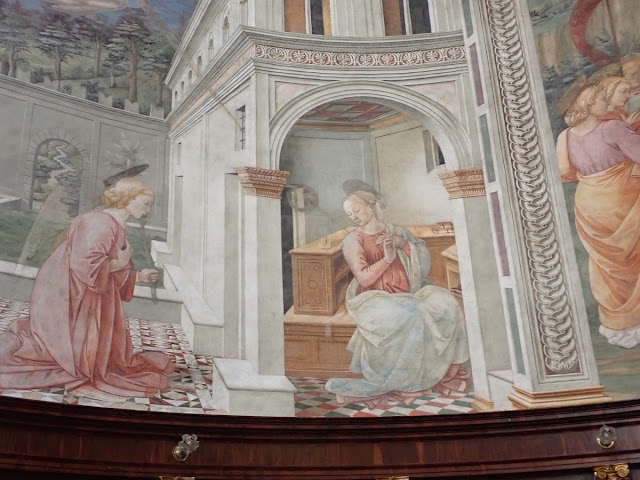
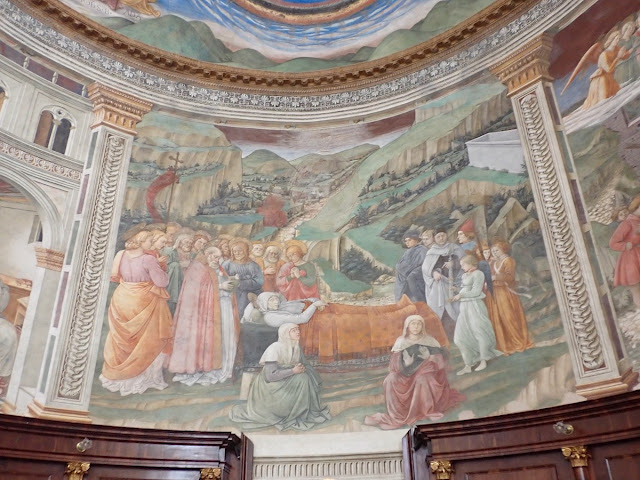





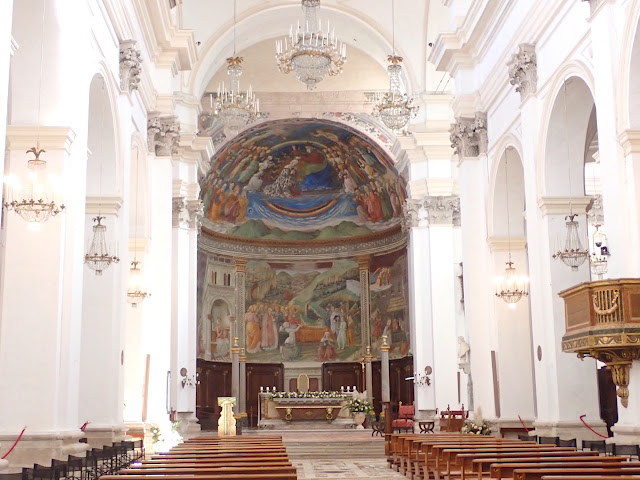



























Wowser. I just skimmed this, but I'm going back to study it more closely. Fabulous trip
ReplyDeleteThe duomo was amazing. I love their entrances. They know how to accentuate a portal.
ReplyDeleteMakes we want to go back to Italy pronto!! Love the Lippi paintings (and the back story too of course . . .) and just all the detail that catches your eye and which you record in your words and pictures. Sights, sounds, tastes. Your sun ray clock: delightful! And yes that gelato combo does sound just perfect.
ReplyDelete